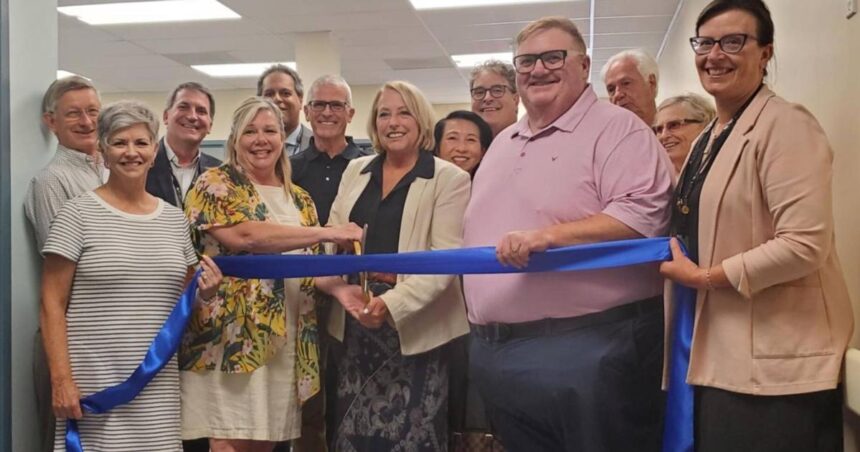The chill of an early winter morning hangs in the air as I pull into the Huntsville District Memorial Hospital parking lot. Inside, there’s an unmistakable energy—not the usual quiet tension of a rural medical facility, but something closer to celebration.
“This has been seven years in the making,” says Katherine Craine, CEO of the Huntsville Hospital Foundation, her voice catching slightly as she guides me through the corridor toward what everyone here simply calls “the new suite.” Her emotion is understandable—in rural communities like this one, nestled in Ontario’s cottage country, critical healthcare infrastructure often takes years of community fundraising and advocacy.
Today marks the culmination of that work: the official opening of Huntsville’s first-ever MRI suite, a $5.4 million project that transforms healthcare access for residents across Muskoka and surrounding regions.
“Before this, patients would travel to Orillia or even Toronto,” explains Dr. Melanie Mar, a local physician who joins us on the tour. “That’s a minimum two-hour drive each way. For elderly patients or those with mobility issues, that journey could be physically painful, financially burdensome, and sometimes impossible during winter conditions.”
The statistics underline the critical nature of this development. According to Ontario Health data, patients in northern and rural communities face wait times for diagnostic imaging that can be up to 60% longer than their urban counterparts. For time-sensitive conditions where early diagnosis dramatically improves outcomes, these delays can have life-altering consequences.
Walking into the new suite, the 1.5 Tesla MRI machine gleams under carefully calibrated lighting. What strikes me most isn’t the technology itself—impressive as it is—but the thoughtful design of the surrounding space. The walls feature a panoramic mural of Muskoka lakes, and the ceiling above the machine displays a calming forest canopy scene.
“The environment matters tremendously for patient comfort,” says MRI technologist Jennifer Wilkins. “Many patients experience claustrophobia or anxiety during these scans. Creating a space that feels connected to our natural surroundings helps ease that stress.”
This attention to patient experience reflects a growing understanding within healthcare systems that technical capability and healing environments must evolve together. Research published in the Canadian Medical Association Journal shows that patient anxiety can significantly impact diagnostic quality in imaging procedures, making calm-inducing design elements a practical clinical consideration, not merely an aesthetic one.
The journey to bring this technology to Huntsville reveals much about how rural healthcare adapts and evolves in Canada. The project required a complex funding partnership between the provincial government, which covered operational costs, and the community itself, which raised over $5 million for equipment and construction.
“Almost everyone in town has a connection to this project,” says local business owner Mark Quiring, who contributed to the fundraising campaign. “Either they’ve had to make that long drive for an MRI themselves, or they know someone who has. This wasn’t just about building infrastructure—it was about keeping our community whole.”
The “keeping whole” he references has multiple dimensions. Beyond the immediate medical benefits, there’s mounting evidence that healthcare access plays a crucial role in rural community sustainability. A 2021 report from the Rural Ontario Institute found that healthcare accessibility ranks among the top factors influencing population retention in small communities.
As afternoon light filters through the hospital windows, I join a small gathering of staff for their first training session with the new equipment. The conversation flows between technical specifications and personal stories—nearly everyone has an anecdote about a friend or family member whose care was compromised by diagnostic delays.
The MRI suite is expected to perform approximately 3,500 scans annually, dramatically reducing wait times across the region. For conditions like stroke, where the Canadian Stroke Network emphasizes that “time is brain,” this local access could quite literally save lives and prevent disability.
“We’ll be able to provide same-day emergency scans when needed,” explains Dr. Sayra Deutsch, the hospital’s chief of staff. “That capability simply didn’t exist here before.”
The implications extend beyond emergency care. For chronic condition management and cancer screening, regular access to advanced imaging means earlier intervention and more personalized treatment plans. This aligns with Health Canada’s strategic priorities for rural health equity, which increasingly focus on bringing specialized services to patients rather than requiring patients to travel to urban centers.
As my visit concludes, I speak with Elaine Smith, a 72-year-old Huntsville resident who received one of the first scheduled scans in the new facility. Last year, suspicious findings on an ultrasound led to an MRI referral that required her to make three separate trips to Orillia due to scheduling and transportation challenges.
“Having this here means I can maintain my independence,” she tells me. “My daughter doesn’t need to take time off work to drive me, I don’t need to worry about winter road conditions, and the whole experience is just less… overwhelming.”
Her experience encapsulates what healthcare access truly means in rural communities—not merely the presence of technology, but the preservation of dignity, autonomy, and community bonds.
The Huntsville MRI suite represents more than a single technological advance in a small-town hospital. It embodies a vital principle in Canadian healthcare: that geography should not determine destiny when it comes to health outcomes.
As communities across Canada’s vast rural landscapes continue to advocate for equitable healthcare access, Huntsville’s journey offers both inspiration and a practical roadmap. The combination of government support, community determination, and healthcare innovation demonstrated here shows how the gaps in our healthcare system can be bridged—one community at a time.
When I look back at my notes from the day, one comment from Katherine Craine stands out: “This isn’t just about having an MRI. It’s about telling people they matter, regardless of where they live.” In that simple statement lies the heart of rural healthcare advocacy—and the profound impact of Huntsville’s new MRI suite.






